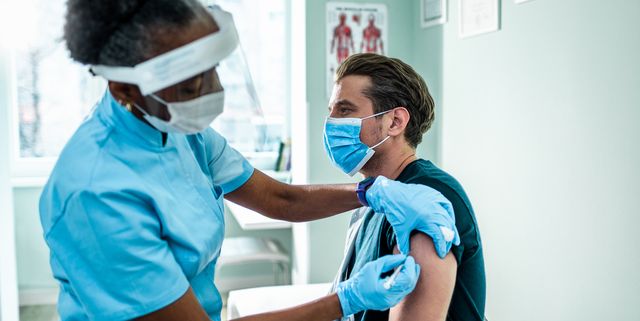More than 28,000 cases of monkeypox have been diagnosed since the Centers for Disease Control and Prevention began tracking an international outbreak of the virus in June. People who contract monkeypox can present a variety of symptoms, including fatigue, fever, muscle aches, swollen lymph nodes, and—most noticeably—a painful, contagious rash on the skin of the face, hands, and other parts of the body.
But while awareness of the disease itself is on the rise, there is still a lot of confusion over who can get it, and how. And if we don’t clear that up, a lot more people are going to suffer.
This week, the Associated Press reported that the spread of monkeypox could “represent the dawn of a new sexually transmitted disease” and become “an entrenched STD” like HIV. This is factually incorrect. Medical professionals on social media were quick to point out the flaws in the AP’s statement, clarifying that monkeypox is not a sexually transmitted disease and that describing it as such is disinformation.
When it comes to medical misinformation, the wrong wording can be highly dangerous from health and human rights perspectives. The public language and framing around healthcare needs to be incredibly clear and specific, otherwise entire communities may end up underestimating or even dismissing their own risk levels. Additionally, muddled messaging or worse, language which implies blame can end up emboldening existing stereotypes and biases, exacerbating the discrimination faced by already-marginalized groups. We saw it happen just last year, with the uptick in anti-Asian sentiment which was found to be linked directly to statements made by then-President Trump about the origins of the coronavirus.
There have been comparisons between the monkeypox outbreak and the HIV/AIDS crisis of the 1980s, when misinformation and social taboo surrounding the virus led to the widely held assumption that only gay men were susceptible, a myth which has been disproven but which nevertheless perpetuated the demonization of the LGBTQ+ community. This belief was bolstered by the conservative idea that queer sex is dirty, shameful and immoral, and that the people contracting HIV somehow deserved what happened to them—a lie that simultaneously left other demographics vulnerable to the disease as they thought themselves safe, with no real understanding of how the virus spread.
In the context of monkeypox, men who have sex with other men have been identified as a higher risk group and have therefore been prioritized in the rollout of the vaccine—but that does not make monkeypox a “gay” disease. Similarly, the fact that many within the LGBTQ+ community are actively seeking out vaccines has been interpreted as confirmation that they are the only ones at risk, when it is more likely a sign of lessons that have been hard-learned over the last three decades.
According to the CDC, the monkeypox virus spreads via close person-to-person contact; this can include through both skin touch and respiratory secretions during kissing, hugging and sex, but there are other ways that it can be transmitted, such as touching items that have been exposed to the infectious rash or bodily fluids. Critically, the CDC website states that “anyone can get monkeypox if they have close personal contact with someone who has symptoms of monkeypox.”
Hear that? Anyone.
The increasingly prevalent idea that monkeypox is both sexually transmitted and exclusive to gay and bisexual men is only going to lead to scapegoating of this community, and a continued foothold for the virus. In fact, it’s already happening. When news broke this week that there are now cases of children being diagnosed with the disease who may have got it from adults, it came without clarification that this is not an STI. While you might think that making this kind of distinction is unnecessary—surely anybody with common sense would not immediately assume those cases were sexually transmitted?—it creates room for willful misinterpretation by homophobic and transphobic voices.
The idea that LGBTQ+ people are somehow trying to corrupt or recruit children is a popular false narrative. Headlines declaring gay men a threat to minors were once commonplace, while trans and nonbinary people have been deemed the newest supposed threat by right-leaning media, with “groomer” becoming the go-to refrain against queer people online. Again, you might think that this is an illogical leap, but there is sobering historical precedent.
“It’s a despicable attack, but it’s not a new tactic,” LGBTQ+ activist Evan Wolfson recently told NPR, responding to the explosion of the groomer narrative. “This is a classic trope of dehumanization and fear that has been used against gay people decade after decade after decade. … Think about the calumny against gay people throughout most of our lifetimes: that gay people somehow are molesting kids, or after kids, or predatory.”
At a time when hate groups are pushing the groomer myth and jumping on every possible opportunity to “prove” that queer people are a threat, no matter how tenuous, any kind of lax communication surrounding public health concerns can create a very real risk of violence. And while they’re busy scapegoating the gays, monkeypox is still spreading through touch regardless of identity.
Philip Ellis
Philip Ellis is a freelance writer and journalist from the United Kingdom covering pop culture, relationships and LGBTQ+ issues.
This content is created and maintained by a third party, and imported onto this page to help users provide their email addresses. You may be able to find more information about this and similar content at piano.io
Discovered on: 2022-07-26 21:33:00
Source: Calling Monkeypox an STI Isn’t Just Misleading. It’s Dangerous.


